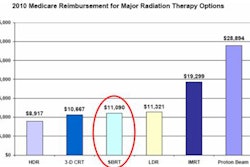When President Barack Obama signed U.S. healthcare reform into law in March, he changed the healthcare landscape. Now, radiology groups and imaging centers are hard pressed to figure out exactly how the legislation will affect them.
Healthcare reform will result in a change in payor mix for many radiology businesses, and it will produce an increase in Medicaid and a decrease in self-pay patients, according to Worth Saunders, CEO at Greensboro Radiology in Greensboro, NC.
"Not just in this [healthcare reform environment] but in overall economics, patient responsibility in terms of copays and deductibles will continue to go up, and that's a challenge from a collections standpoint, particularly given the economic downturn," Saunders said. "We have already seen an impact in terms patients not opting for tests as much. Of course, this could be somewhat offset by new patients, particularly Medicaid, that enter the system in 2014."
In any case, to thrive going forward, radiology groups or imaging centers would do well to get a handle on their operations.
The big picture: Understand costs and revenue
Physician groups and imaging centers need to have a thorough understanding of both their reimbursement by payor and their costs per procedure, according to Jon Geise, principal at 3d Health, a Chicago-based firm that provides consulting services to healthcare providers. This information will give the practice better leverage in negotiations with commercial payors.
"The big issue [as healthcare reform unfolds] is how commercial payors are going to trend," Geise said. "Will they follow Medicare? It's important for radiology practices with imaging centers and other freestanding providers to pay close attention to commercial contracts as they come up for renewal."
By managing costs per procedure to the lowest payor, groups are in the position to present themselves to insurers as a low-cost provider without compromising their own bottom lines.
"We tell our imaging center clients that there's an opportunity to go to commercial payors and make a proposition: We'll manage utilization through appropriateness criteria for you within a lower cost setting compared to the local hospital -- in exchange for volume and a reasonable level of reimbursement," Geise said. "If a practice or a center is able to manage costs to their lowest-margin payor, everything else will take care of itself."
Radiology groups or imaging centers need to have a clear sense of what's feeding their revenue stream -- where exactly it comes from and how to maximize it, according to Geise.
"Many in the market don't know exactly what they're supposed to get from their commercial payors, especially since those payors don't report line item reimbursement, but often distribute a lump check for whatever scans a patient had," he said. "But groups or imaging centers can do retrospective analyses on their billing, making sure that what they got paid for a particular patient is what they were supposed to get."
Five practical actions
There are five things imaging centers or physician groups should pay attention to in order to thrive, according to Geise:
- Examine pricing: Set fees appropriately and make sure the practice isn't priced out of the market.
- Spot check managed care contracts: What is each insurer paying?
- Evaluate volume and understand fixed costs per scan: How is the center or practice covering fixed costs on a per-scan basis? How much volume is the center producing?
- Take a look at variable costs, such as staffing and medical supplies: How much does the practice spend on variable costs per scan? How does this compare to benchmarks?
- Track each payor's margin: At the end of the day, what percentage margin does the practice take home from each payor?
Track the whole process
David Haws, chief financial officer at Pueblo Radiology in Santa Monica, CA, uses financial operations management software to perform trends and profitability analyses and to track whether insurers are paying, what they're paying, and whether the payments are timely.
"We watch the revenue side very closely, monitoring who our referring physicians are, how many referrals we get from them, what reimbursement levels we're getting for scans, and the productivity of our physicians," he said. "We want to be accurate and maximize the reimbursement we receive."
Key to becoming efficient is carefully tracking the whole patient care process, from the time the referring physician places the order for a scan, verifying patients' insurance and deductibles before taking the scan, ensuring the correct scans are performed, and keeping an eye out for unauthorized scans, according to Haws.
"We want to capture 100% of what we're entitled to," he said.
With the financial operations management software, Pueblo Radiology can dig deep into its records, periodically reviewing the profitability of its various lines of service -- for example, interventional services -- by determining what the actual costs are and checking that number against CPT codes.
"The bottom line for us is trying to be smart about the services we provide," Haws said. "And that comes from constant review of our financials to make sure we're as efficient as possible."
By Kate Madden Yee
AuntMinnie.com staff writer
May 20, 2010
Related Reading
Life after healthcare reform: Good, bad, and ugly, May 13, 2010
Obama signs final healthcare changes, defends law, March 30, 2010
Healthcare changes head to Obama for signature, March 26, 2010
Final answer on equipment use rate: 75% in 2011, March 26, 2010
Healthcare changes headed back to House, March 25, 2010
Copyright © 2010 AuntMinnie.com




















